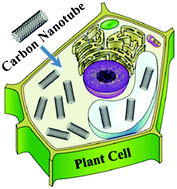Carbon nanotubes (CNTs) are at the forefront of cutting edge research in a variety of fields. In recent years, they have attracted the attention of plant biologists as potential molecular transporters, due to their intrinsic ability to cross the cell membrane of different types of mammalian cells as drug and gene delivery vehicles.

The potential of CNTs to cross plant cell walls for various, specific purposes could open up an enormous array of applications in the fields of plant biotechnology and agricultural biology from the entire plant level down to the cellular and molecular level.
Read this article for free until the 21st February 2013!
Nanobiotechnology meets plant cell biology: carbon nanotubes as organelle targeting nanocarriers, Maged F. Serag, Noritada Kaji, Satoshi Habuchi, Alberto Bianco and Yoshinobu Baba, RSC Adv., 2013, DOI: 10.1039/C2RA22766E
Stay up-to-date with the latest content in RSC Advances by registering for our free table of contents alerts.










